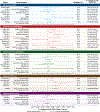Health Effects of Wildfire Smoke Exposure
- PMID: 37738508
- PMCID: PMC12183787
- DOI: 10.1146/annurev-med-052422-020909
Health Effects of Wildfire Smoke Exposure
Abstract
We review current knowledge on the trends and drivers of global wildfire activity, advances in the measurement of wildfire smoke exposure, and evidence on the health effects of this exposure. We describe methodological issues in estimating the causal effects of wildfire smoke exposures on health and quantify their importance, emphasizing the role of nonlinear and lagged effects. We conduct a systematic review and meta-analysis of the health effects of wildfire smoke exposure, finding positive impacts on all-cause mortality and respiratory hospitalizations but less consistent evidence on cardiovascular morbidity. We conclude by highlighting priority areas for future research, including leveraging recently developed spatially and temporally resolved wildfire-specific ambient air pollution data to improve estimates of the health effects of wildfire smoke exposure.
Keywords: air pollution; environmental health; epidemiology; public health.
Figures


References
-
- Jones MW, Abatzoglou JT, Veraverbeke S, et al. 2022. Global and regional trends and drivers of fire under climate change. Rev. Geophys. 60(3):e2020RG000726
-
- Jain P, Castellanos-Acuna D, Coogan SC, et al. 2022. Observed increases in extreme fire weather driven by atmospheric humidity and temperature. Nat. Climate Change 12(1):63–70
Publication types
MeSH terms
Substances
Grants and funding
LinkOut - more resources
Full Text Sources
Medical

